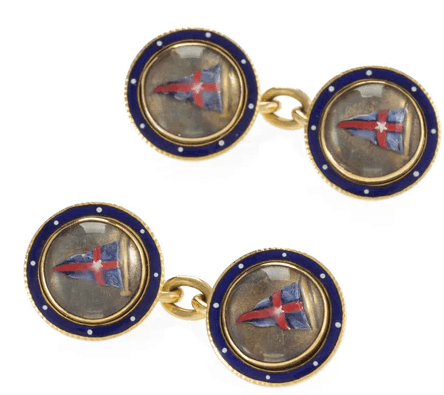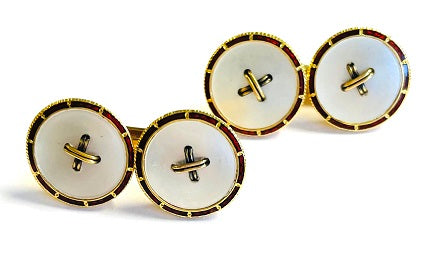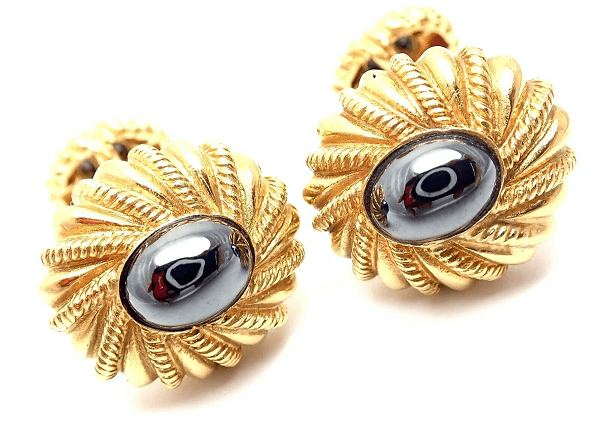Beautiful baubles that fasten your sleeves together, wearing cufflinks is a way to set yourself apart from the pack. While cufflinks at one time were worn every day, since the middle of the 20th century, they have been relegated to formal wear. However, cufflinks need not be only for weddings and black tie occasions. In fact, if you want to be the coolest person in the room show up at a spring or summer soiree wearing the usual shorts and sneakers. But why not take your game up a notch and instead of a tee shirt, wear a shirt with French cuffs and cufflinks. It’s a great casual look that’s perfect for going out to dinner or for date night.
Origins of Cufflinks
Where did cufflinks come from and how did they become an important part of a well-dressed gentleman’s wardrobe? In order to understand the origins of cufflinks we have to take a look at men’s fashion through the years, especially the shirt. Originally men’s shirts were made to pull over the head because they didn’t have buttons and while buttons existed for decorative purposes, functional buttonholes took a while to be invented. Sleeves, were big and billowing with cuffs that needed a closure. To accommodate this need, a string, leather cord, or ribbon was used to tie the cuffs closed.
It was during the 1600s that the precursor to what we know today as cufflinks developed. By this time the reinforced button hole had been developed which made it sturdier and able to hold something heftier than a string. The button holes were connected by decorative buttons, known as “bouton de manchettes”, which is French for sleeve buttons. These sleeve buttons were comprised of two buttons held together by a small chain. Bouton de manchettes became popular with nobility and aristocrats and it didn’t take long before jewelers began making sleeve buttons from precious metals and gemstones. They were labor intensive, hard to make and as a result very expensive, which is why they were only worn by the elite. Cufflinks got a big boost in popularity from King Charles II, who reigned over England from 1660 to 1685. The King was a fan of cufflinks and wore them frequently, which brought them to the attention of many.
During the 1700s cufflinks were often commissioned by royalty and nobility for specific occasions. These jewels were often adorned with initials, crests or other designs and were a symbol of wealth and status. Interestingly, cufflinks during this period were gifted rather than self-purchased and most cufflink collections got started that way. Cufflinks were still very expensive during this time so they continued to be reserved for those with money.
Cufflinks Become Attainable
It was the Industrial Revolution that really helped cufflinks become an everyday accessory. There were two reasons, first the Industrial Revolution allowed cufflinks to be made more easily making them more affordable to a broader range of society. It also created a lot of new wealth and a rising middle class that worked in office jobs. In 1866 Newark, New Jersey-based Krementz & Co., inspired by a bullet making machine, developed new machinery for manufacturing these accessories. This invention made cufflinks faster and easier to produce so they became accessible to a mass market at a less expensive price.
Cufflinks For Casual Wear
The formality of the Victorian era continued into King Edward VII’s reign (1901-1910) making cufflinks an even more important accessory for men at the turn of the 20th century. Cufflinks reached the peak of popularity during the early 1900s when people dressed up to go out to clubs and parties. They maintained their popularity into the middle of the century, when changes in fashion and lifestyle made them less necessary. By this time men’s dress shirts came with cuff buttons, so there was no need for cufflinks. At the same time, more casual lifestyles were taking hold. Cufflinks were still worn for special occasions, black-tie events or weddings, but most people stopped wearing them as an everyday part of their wardrobe.
Cufflinks are making a big comeback today as apparel takes a turn to sharp tailoring and luxe details. Today, cufflinks are no longer the exclusive domain of men, women sometimes don these lovely baubles as well when wearing a suit, after all like most jewelry, cufflinks are another way to show the world your unique style and personality.
Featured image (top of page): Art Deco coral, onyx, diamond, platinum and gold cufflinks.
First: Hand hammered 18-karat gold knot cufflinks, signed Henry Dunay, circa 1990s; Second: Victorian rock crystal and enamel Benzie and Cowes New York Yacht Club cufflinks; Third: Edwardian mother-of-pearl, enamel and gold cufflinks; Fourth: Hematite and gold cufflinks, signed Jean Schlumberger for Tiffany & Co., circa 1980s.
Authored by Amber Michelle





